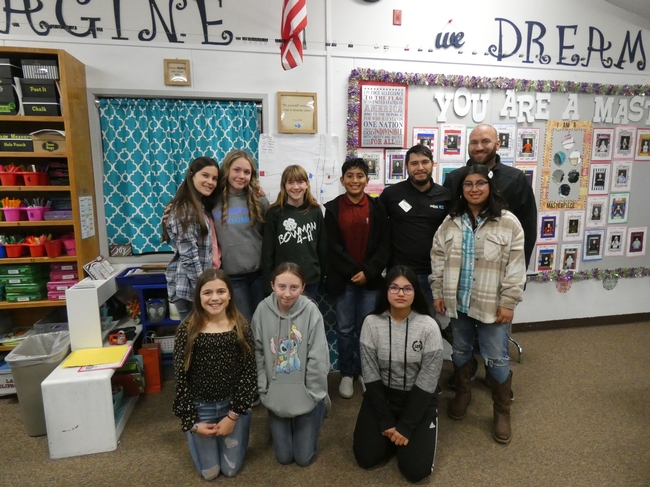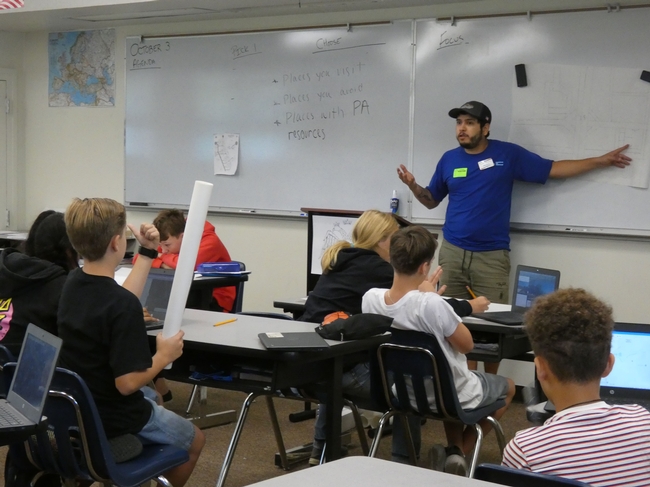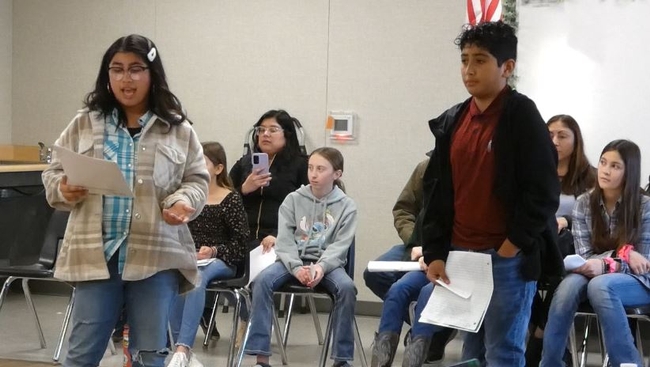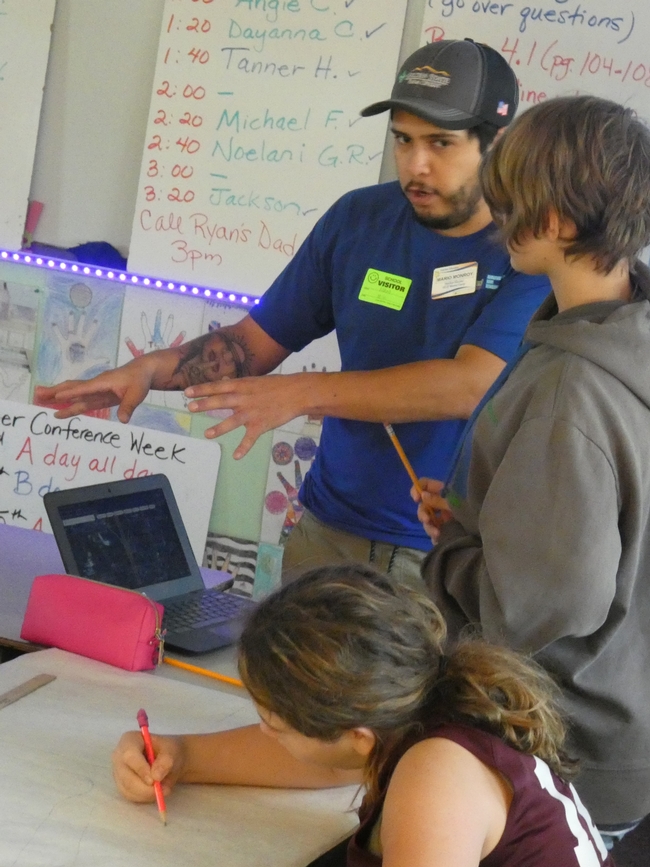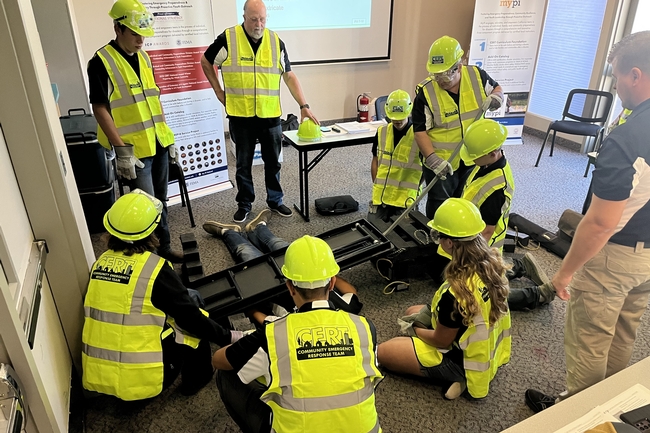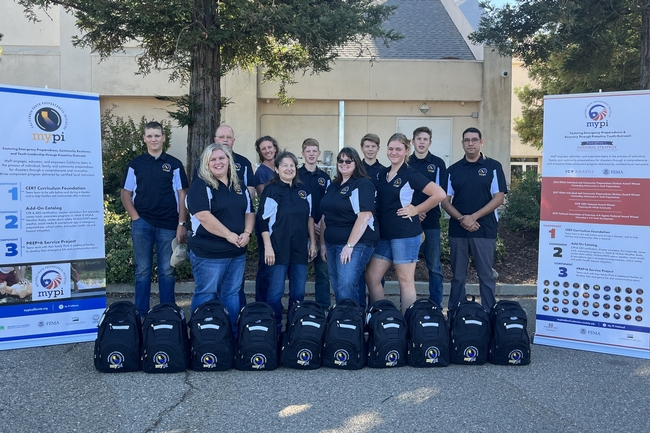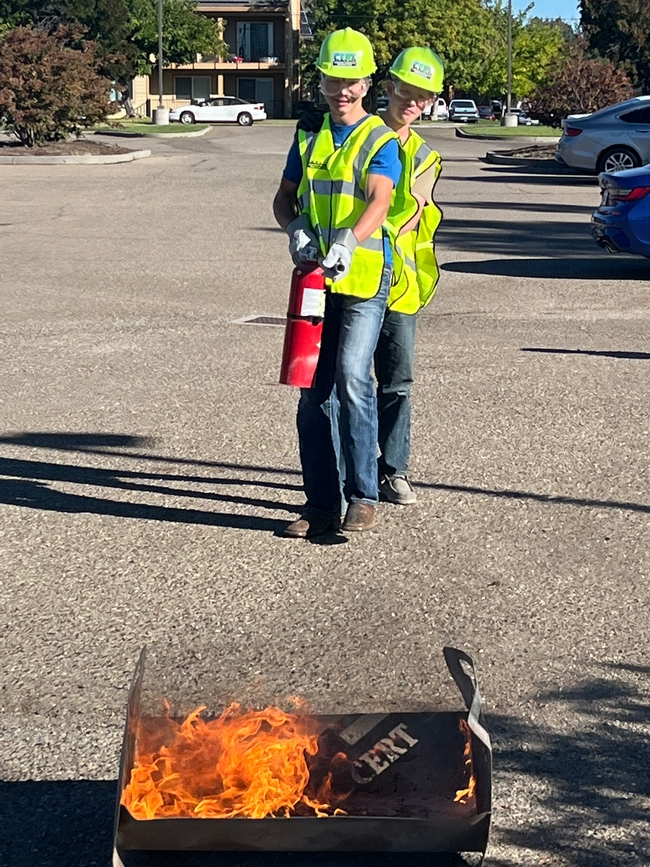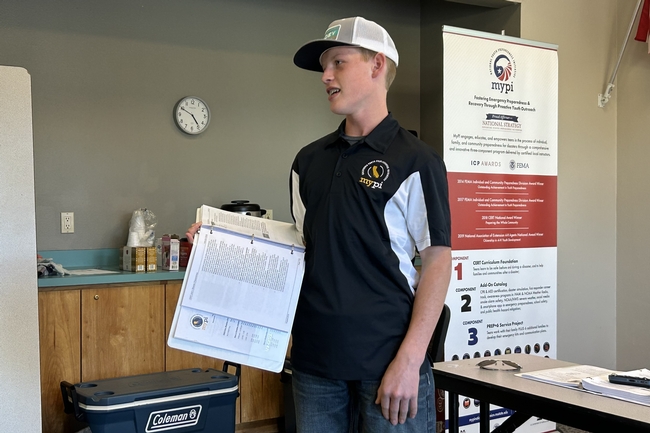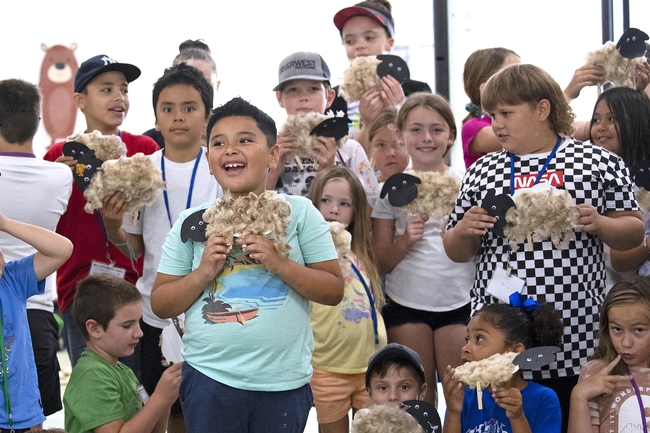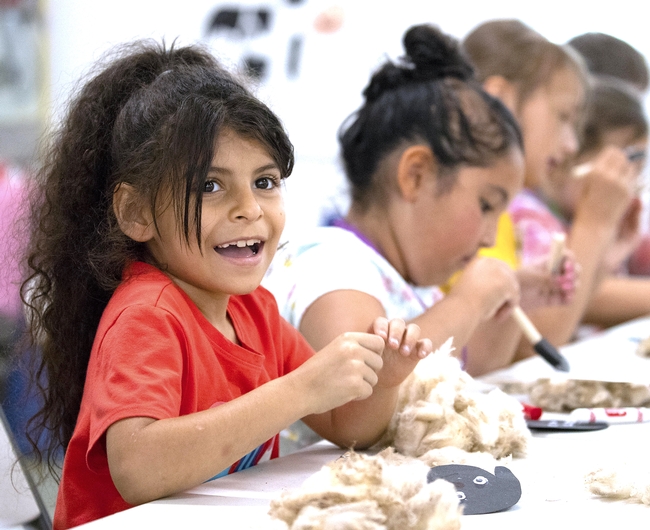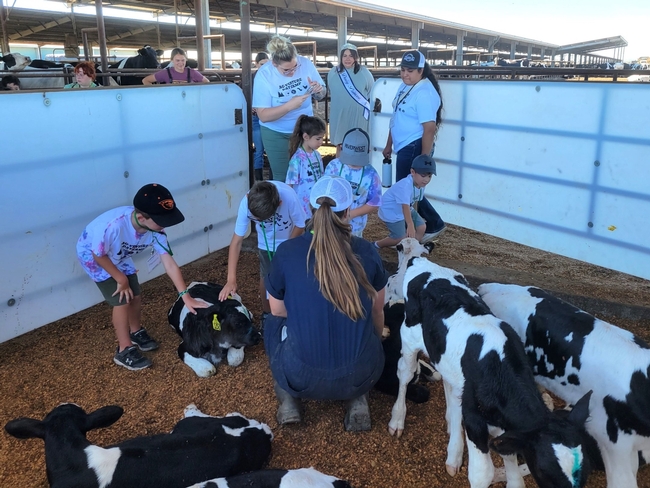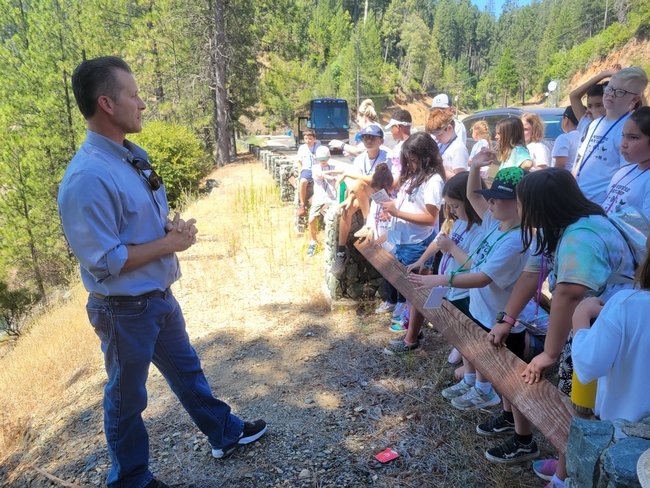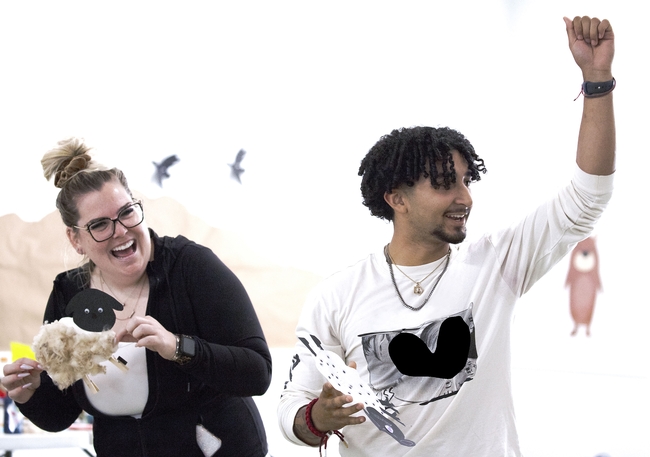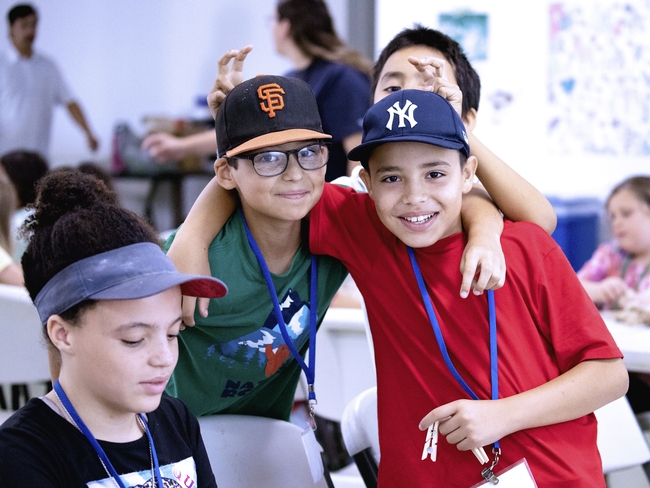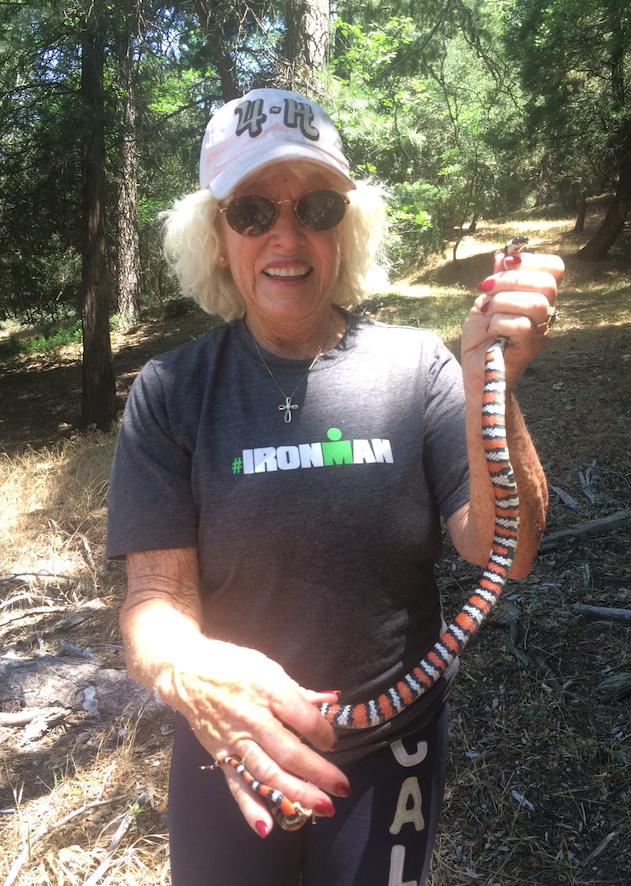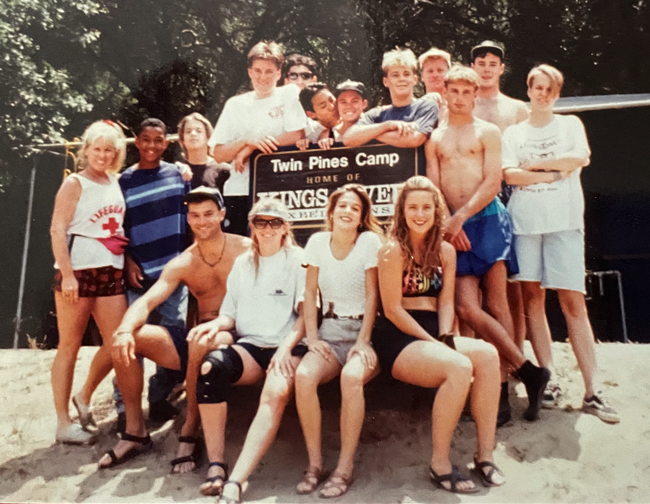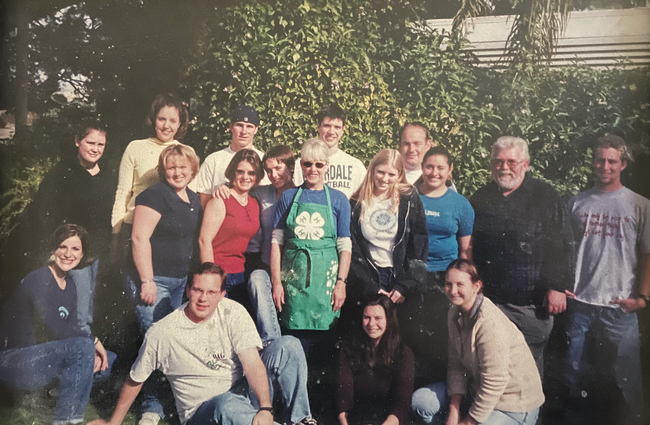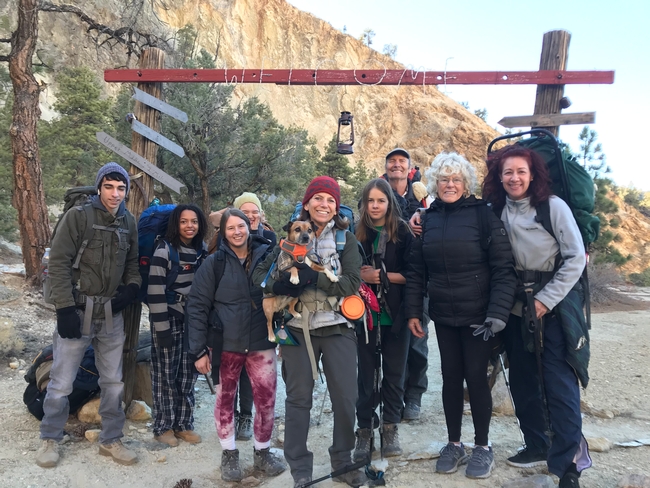- Author: Michael Hsu
Tehama County students empowered by CalFresh Healthy Living, UCCE educator and teachers
It's not uncommon for high school or college students to speak up and seek to improve their school environment. But at Evergreen Middle School in Tehama County, more than 100 sixth graders led the way to create healthy changes at their school.
As part of their health classes during the 2022-23 school year, the students researched the availability of spaces for physical activity, developed a survey gauging their peers' health awareness and needs, analyzed the results and data, and made recommendations for improvements.
“We learned that there's not a lot of places – except for Evergreen Middle School and some other parks around [our community of] Cottonwood – that have many physical activity places that you can easily get to or have access to,” said Bailey, one of the students.
They were guided by Mario Monroy-Olivas, a nutrition educator with CalFresh Healthy Living, University of California Cooperative Extension in Tehama, Shasta and Trinity counties. Locally administered by UC Agriculture and Natural Resources, CFHL, UCCE is one of the agencies in California that teaches nutrition to people eligible for SNAP (Supplemental Nutrition Assistance Program) – referred to as CalFresh Food in California.
Working alongside Evergreen teachers Roxanne Akers and Albert Estrada, Monroy-Olivas challenged the sixth graders to tackle a “Youth Participatory Action Research” project – a yearlong, multi-step undertaking typically designed for older teens.
“The fact that we're doing it with these younger kids, starting a lot sooner, I think it's super impactful for them to know that, together, collectively they can make huge changes that will create positive outcomes – not just for themselves but for an entire community,” Monroy-Olivas said.
Middle school students speak up at school board meeting
In February 2023, eight class representatives presented their findings to the Evergreen Union School District Board of Education. Speaking before the five-member board for 20 minutes, the young people were naturally a bit nervous.
“It was a little nerve-wracking at first, but it wasn't that bad, once we got up there and got it over with,” said Lilah, one of the presenters. “Me and a couple of my friends were doing pep talks and practicing what we were going to say.”
The students showed a composite map that they drew from their classes' investigation of spaces for physical activity in the area, and shared a brochure that outlined their research and survey results. In a survey of more than 80 of their peers, 92% of respondents said they needed more access to physical activity equipment during class breaks, recess and lunch.
“The board members were super impressed with the students, coming to the school board and doing this,” Monroy-Olivas said. “They said they haven't had students doing this kind of advocacy work; for them, it was a really big deal.”
In the end, the young people made a strong case for more water-bottle refilling stations, badminton equipment and balls for other sports, and stencils for schoolyard activities like hopscotch, four square and snail (a type of hopscotch game).
“We got almost everything we asked for, and the project we're working on now is to help put in the things we asked for,” said Lilah, adding that, during this current school year, the students (now in seventh grade) are working on acquiring the stencils and paint.
More than just equipment, students gain skills and confidence
While the promise of new gear is exciting for the youth, they are acquiring something even more valuable and enduring – a sense that they are empowered to make a difference in their community, according to Janessa Hartmann, UC Cooperative Extension community nutrition and health advisor for Tehama, Shasta and Trinity counties.
“Yes, it's important to want to do stencils and hydration stations and have more equipment,” Hartmann said, “but the bigger impact for the students is that they think: ‘Now I know that my health is important, now I know how to advocate for myself, and now I know that I can do that.'”
Monroy-Olivas said he observed tremendous growth in all the students, and especially in the self-confidence of the class representatives.
“I grew as a leader because I used to be really shy and hated talking in front of people, but through this project we're doing, this has really helped me be able to talk in front of crowds – and listen to others,” Lilah explained.
In a survey at the end of the sixth-grade project, the percentage of youth who answered “Yes, most definitely” to the statement “I want to make a difference in making my school/community healthier” jumped from 19% before the project to 44% after. And that percentage of “Yes, most definitely” replies jumped from 6% to 31% for the statement “I can use research results to come up with solutions or recommendations for making my school/community a healthier place.”
“We learned to promote what we want and try to get it as much as we can, so we can get more physical activities and more people can be included,” said Brian, another student working on the project.
“It's important so when we get older, we know how to voice our opinions and let people know what we're thinking,” added classmate Brooklynn.
Wishing that he had such an opportunity when he was growing up, Monroy-Olivas said he feels the students now know the power of their voice.
“I wholeheartedly believe that's the biggest win out of this whole project, that they're learning how to advocate for their own voice and change,” he said.
- Author: Michael Hsu
4-H leaders, youth complete state's first MyPI instructor certification workshop in Tehama County
Disasters do not discriminate. They can impact people regardless of their race, color, creed, socioeconomic status – or age. That's why a nationwide effort to train young people in emergency preparedness continues to grow and is establishing itself in California.
The national MyPI (Preparedness Initiative) program, developed by Mississippi State University Extension, partnered with California 4-H this fall to train the state's first cohort of instructors, who will then lead trainings for young people in the coming months. With Northern California as the catalyst, organizers plan to spread the program across the state, said Nate Caeton, 4-H youth development advisor for Shasta, Tehama and Trinity counties.
“If you look at the research, everybody is affected by disasters, but young people even more so, for a number of reasons – whether because they don't fully understand what's going on, or they don't have the same experience or skill sets as adults,” said Caeton, who serves as the MyPI California manager. “But this takes a huge leap in addressing that.”
California is the 28th state/territory-level program to partner with the national MyPI team to train instructors – but the first to allow young people to participate in the three-day instructor workshop.
Of the 11 4-H-affiliated participants who completed the October training in Red Bluff, five were teenagers. The workshop, led by national MyPI trainers, included comprehensive Community Emergency Response Team (CERT) content developed by the Federal Emergency Management Agency, known as FEMA – covering medical operations, fire safety, light search and rescue, disaster psychology and more.
“By the end of day 1, the trainers were already commenting on the maturity level of the teens who had attended,” Caeton said. “They've been doing this training for a long time and they were definitely impressed – that says a lot about our young people.”
Potential disasters necessitate preparation by all
Bodie, a ninth grader in Shasta County, said the MyPI California workshop gave him a new perspective on his father's role and responsibilities as a CAL FIRE battalion chief.
“It was a great class, a great experience,” said Bodie, who participated in the training with his two brothers. “It was a 30-hour-long class – really long, but really fun; there was a lot of hands-on learning.”
Katy Zulliger, Bodie's mother, also attained instructor certification through the workshop. She said that, in their city of Redding and communities across the region, there remains considerable trauma from the devastating fires of 2018 – the Carr Fire and Camp Fire. Zulliger said that educating and preparing the public – including youth – will be crucial in meeting future challenges.
“There's a lot that can happen around here – from earthquakes to fire to flood to mudslides, and the list goes on and on…even, living on I-5, potentially tanker trucks spilling over,” she explained. “It's smart for the kids to learn how to think outside the box.”
Bodie noted that the workshop has made him more aware of his surroundings and potential contingency plans.
“When I'm out in the town, I really do think about what can happen in different scenarios – for example, maybe an earthquake or active shooter situation – and I ask myself, ‘What would I do? How would I respond?'” said Bodie, who is considering a career as a first responder.
Youth have a voice, role in boosting community resilience
The skills and knowledge gained from the MyPI program can equip young people to be leaders among their peers, and even in the broader community, when emergencies arise.
“Kids can actually use this and be engaged – instead of just being a watcher or video taker,” said Zulliger, a 4-H volunteer who has served as a club leader of the Palo Cedro 4-H club. “They have a voice and they can use it positively.”
Her sons – and the other two teens who completed the workshop – will help adult instructors organize and deliver the 10- to 12-week MyPI training to young people in their communities. As part of the program, tentatively slated to begin in Northern California by summer 2024, youth participants will be required to work with their families to create an emergency communications plan, assemble a disaster kit, and reach out to six other households to make similar preparations.
“This gives them some ownership over their own personal preparedness and the preparedness of their family and those they are closest to,” Caeton explained.
By partnering with schools, 4-H clubs and community groups, Caeton said the goal is to deliver the program to 125 young people, across five Northern California counties, by summer 2025 – before expanding participation across the state.
“I'm hoping it spreads like wildflowers, because it's definitely needed,” Zulliger said.
- Author: Mike Hsu
UC Cooperative Extension team in Sutter and Yuba counties showcases UC ANR programs, community partners
When dozens of elementary schoolers gathered to watch a live calf birth at Tollcrest Dairy in Yuba County, their comments ranged from “disgusting but cool” to “I saw something that maybe I'm too young to see.”
Expanding horizons, growing knowledge and gently pushing some limits were at the heart of a four-week day camp, Ag-Venture, organized by the University of California Cooperative Extension office serving Sutter and Yuba counties.
Throughout July, more than 80 campers – ages 5 through 12 – explored agriculture and science topics through field trips across the region, hands-on activities and lively presentations by UCCE advisors, UC Master Gardeners, 4-H specialists, UC Master Food Preservers and CalFresh Healthy Living, UC educators. All these groups fall under the umbrella of UC Agriculture and Natural Resources.
A grant from The Center at Sierra Health Foundation funded this day camp for underserved youth focused on agriculture and natural resources – the first of its kind in the area. Exploring the themes of “Interesting Insects,” “Foods and Farms,” “Woods and Water” and “Awesome Animals,” the campers learned directly from community experts and UC ANR scientists.
“Some of the kids might think scientists are only wearing lab coats and working with genetics and DNA and human-based science, but here they got to see agricultural scientists and natural scientists,” said Rayna Barden, the 4-H community education specialist who led the camp. “It was a cool way to showcase what ANR does and what we have to offer.”
Youth gain wide range of experiences, knowledge
Visits to local farms and ranches – with many chances to greet the animals – were a highlight for many of the camp participants.
“I liked learning about agriculture and the interactive activities,” said a fourth grader. “I saw a baby cow coming out of its mama, and they [farm staff] had to use a tool. It was cool.”
A sixth grader said: “I learned that feed is made up of everyday items, like almond shells and beer hops!”
“Sheep, cows and goats have one stomach and four chambers,” added another sixth grader.
That digestive tidbit was absorbed by the campers after a visit with UCCE livestock and natural resources advisor Dan Macon at Sierra Foothill Research and Extension Center, a facility operated by UC ANR in Browns Valley.
“We have 4-H kids and FFA kids in high school who still don't know how the four chambers work!” Barden said. “These kids had it and it was so cool to see that they remembered that from a previous day.”
Time and time again, Barden said she was amazed at how much the campers retained. After a visit to Bullards Bar Reservoir, a seven-year-old was able to explain why the dam is curved. Another young boy could draw his own interpretation of the water cycle. And several campers talked about the rice presentation for weeks.
Whitney Brim-DeForest, UCCE county director for Sutter and Yuba counties and a rice advisor, had the participants touch and feel different rice seeds and varieties. The campers also got to plant a few rice seeds to take home.
“But their favorite part – and what they talked about for the rest of camp – was the tadpole shrimp,” Brim-DeForest said. “We brought some live and preserved specimens, and they loved them!”
Sparking ideas for future careers
One third-grade camper said she enjoyed learning the differences between agricultural pests and beneficial insects.
“And you can do stuff to help the good bugs,” she said, adding that she would like to pursue a career working with animals and nature.
Expanding awareness among young people of new career possibilities was exciting for Ricky Satomi, UCCE forestry and natural resources advisor for Sutter and Yuba counties. Using interactive exercises (such as those developed by California Project Learning Tree, another UC ANR-affiliated program), Satomi shared his knowledge about resource competition, watershed filtration and fire behavior in forest ecosystems.
“It's always a pleasure to introduce students to the natural resources where they live,” Satomi said. “This is particularly critical given the current workforce shortage we face in forestry; I hope their experience at Ag-Venture will spark interest in future forestry careers, where these students can work to better their local forest communities.”
Young people from local colleges and universities also gained invaluable experience during the camp. Four students helped prepare the camp: Yasmeen Castro Guillen (Chico State), Alana Logie (Yuba College), Jayla Pollard (Folsom Lake College) and Adam Yandel (Chico State). Three more helped lead the camp as counselors: Hector Amezcua (Yuba College), Alyssa Nott (Butte College) and Jillian Ruiz (Chico State).
“They did such a fantastic job, mentoring the kids and serving as positive role models, and we have seen tremendous growth in all of them, too – in confidence, skills and knowledge,” said Brim-DeForest.
A true community effort
Barden emphasized that the sweeping scope and in-depth, intertwining lessons of the camp were only possible through broad support from the greater community. Brim-DeForest highlighted the partnership with Yuba City Unified School District, as well as with Sutter County. Camp HQ was in Ettl Hall, a Sutter County building; campers visited the Sutter County Museum; they also met Yuba-Sutter public health officer Dr. Phuong Luu.
Additional collaborators included Melissa Ussery, CalFresh Healthy Living, UC nutrition program supervisor; Rene McCrory, 4-H secretary; Johnny Yang, UC Master Gardener and Master Food Preserver program coordinator; Matt Rodriguez, 4-H youth development advisor; and Nicole Marshall-Wheeler, 4-H youth development advisor.
“Honestly, we could plan all of this, but without the community's support, our program never would have worked smoothly,” said Barden, who grew up in the small town of Sutter. “Having all of our guest speakers, having all the people who were willing to have up to 50 kids on their property – it just shows how much our community is about our youth.”
Brim-DeForest said Sandy Parker, the camp nurse, exemplifies that spirit. A UC Master Gardener and 4-H alumna and volunteer, Parker also invited the campers to her family ranch, where she introduced the children to her farm animals and Great Pyrenees guardian dog.
The campers certainly appreciated the generosity, teamwork and energy that went into Ag-Venture. Barden said that many of the participants originally had only signed up for one or two weeks – but loved the camp so much that they asked to register for more. And she added that the “vast majority” of them said they want Ag-Venture to come back and would attend in the future.
“Our youth are just so resilient and so willing to learn,” Barden said, reflecting on the camp overall. “Whereas adults, we're usually a little more timid at things, these kids just were willing to dive in, head first, and be in that moment and try to take away as much as they could from what they were offered there at camp.”
- Author: Saoimanu Sope
A typical day for Dee Keese starts with a 10-mile walk at 5 a.m. and her morning wraps up with a swim. Although Keese is in her late 70s, her daily routine would not surprise you if you knew what she has been doing for the last 48 years.
For nearly a half-century, Keese has been the 4-H community leader for the Palos Verdes Peninsula (PVP) club in Los Angeles County. A youth development program managed through local University of California Cooperative Extension offices, 4-H uses hands-on learning experiences to empower youth to build self-esteem and connect with their communities as emerging leaders.
“When you're pushing 80, working with young people helps to keep you young,” Keese said.
4-H has been a game changer in many ways
In the 1970s, Keese moved to the Palos Verdes area with her first-born son who had a learning disability. Others treated him differently in school, and it didn't help that he was the new kid in town. A neighbor encouraged Keese to enroll her son in 4-H.
“She told me, ‘You've got to put your son in 4-H so he can feel good about himself,'” explained Keese. “And let me tell you, it changed my life.”
In 1978, two weeks before her fifth child was born, Keese became the 4-H PVP club's community leader and has been in the role ever since.
While reflecting on her earlier days with 4-H, Keese remembered when most members were boys. Girls were not intentionally excluded at the time; clubs just didn't attract them. When girls eventually joined 4-H, it was a game changer.
“All of a sudden, the program shifted focus from solely agriculture and animals to include home economics like cooking and sewing,” Keese said. “Now, all my sons do the cooking in their homes. It's a good thing! Because we're moving away from traditional domestic duties, men and women are sharing roles, as they should be.”
The PVP 4-H club offers activities like archery, sailing, surfing and geocaching. “Everything we do is to help our youth be better as adults, out in the real world and in the workforce,” said Keese. “We're relying on the internet too much. Kids need to get outside and do things.”
Over the years, Keese has taken members – who range in age from 5 to 19 – on numerous hikes in places like Havasupai Indian Reservation and Mt. Whitney. She's taken them kayaking on the Colorado River and, these days, co-hosts old-fashioned card game nights on the weekends with other community members.
As a lifeguard and water safety instructor, Keese gives free training to interested 4-H members to become lifeguards. Training courses usually cost well over $200 per person. “If they're interested, I train them and they have another skill to use. And it benefits our club,” said Keese. “When we have pool parties or beach days, my kids are prepared to step in and help.”
‘She will help anyone and everyone at any time'
Ace Yeck, former president of the PVP 4-H club, met Keese 12 years ago and decided to become a 4-H member when he was in fourth grade, following a convincing conversation with her. “She just kept giving me opportunities,” said Yeck.
Currently a third-year undergraduate at Loyola Marymount University studying entrepreneurship, Yeck credits 4-H for preparing him for college. “I got all my community service and public speaking practice through 4-H. I remember doing beach clean-ups, feeding the homeless, helping out at the Christmas fair, and all kinds of events,” he shared.
During his years with 4-H, Yeck was elected to the state board as an ambassador before he went on to represent 4-H at the national level. “Dee encouraged me every time, so I kept going,” he said.
Keese admitted that her life is so full and fun because of 4-H. Her motivation stems from the growth and progress that her students experience. “My kids let me know when I've done something to impact their life. It keeps me motivated,” she said.
While thinking about the members she's had over the last 48 years, she couldn't help but stress how important it is that they feel safe. Keese recalls one student who is gay and had a challenging time getting his parents to understand because of religious and cultural barriers. “The family's priest called me and told me that this student felt like I was the only one who loved him,” she said.
“I can talk about Dee forever,” said Yeck. “One of her best qualities is that she will help anyone and everyone at any time. She wakes up at 5 a.m. and goes to bed at, like, 10 p.m. During that time, she's always helping people,” he added.
Because Keese comes from a different generation compared to the kids in her 4-H club, she attributes her successful impact to her ability to adapt. “If we want to keep kids in this, we've got to be flexible! And you've got to do things they like. We can't do things the way it's always been done before,” said Keese. “We have to be flexible.”
To Keese, 4-H is not just an opportunity to teach life skills or introduce kids to agriculture. It's a chance for them to build community.
“That's what I think my generation does well, having grown up in the '50s and '60s,” Keese said. “We're all about that communal living.”
- Author: Saoimanu Sope
Desert REC program has reached more than 168,000 people thanks to broad community support
“Oohs” and “aahs” fill the classroom as Stacey Amparano, Farm Smart program manager at the Desert Research and Extension Center in Holtville, yanks an ear of corn off a stalk. Holding it high in the air, she begins shucking the corn to reveal a bright yellow color.
“It's corn!” yells a member of the audience. Amparano demonstrates how to shuck and shell corn to a group of local kindergarteners, all while explaining its many uses.
Farm Smart, an outreach program focused on agricultural literacy, has educated more than 168,000 people in the Imperial Valley and surrounding areas since its inception in 2001. The program is an integral part of Desert REC – one of nine centers operated across the state by University of California Agriculture and Natural Resources – and serves K-12 students and their families.
Nestled in the southeastern corner of the state, Imperial Valley is home to over 500,000 acres of farmable land and more than 65 crops, making it an ideal place to teach youth about the valley's significant contribution to California, the U.S., and the world.
“Farm Smart is a reminder to kids that they come from a place that feeds most of the country throughout the year. It's something to be proud of,” said Amparano.
While the younger participants might not grasp the full impact of Farm Smart right away, the community sure does. More than 60% of the program's funding comes from contributions from the community, including local organizations, institutions and families.
“I don't think many people realize that a majority of Farm Smart is funded by the community. It makes this program even more special, that our own community believes in our impact and wants us to keep going,” Amparano said.
For example, the Imperial Irrigation District has supported and funded the program since it began, donating $107,500 in 2022 alone.
“This program has created an awareness of how food is grown, harvested and put on our table,” said Norma Galindo, former IID board director. “It invites participation from the elementary through high school grades and serves as a hands-on experience that is priceless.”
During her tenure, Galindo championed the increase of IID's monetary allocation to Farm Smart and requested that older people be allowed to participate in the same manner as the students. This created an opportunity for Farm Smart to engage a segment of the population that is often overlooked. Like the youngsters, retirees escaping cold weather in northern states can learn about irrigation and soils and pick vegetables to take home.
Valeria Landeros, a community education specialist at Desert REC, grew up in the Imperial Valley and remembers attending a Farm Smart field trip in elementary school. “I remember learning how to milk a cow and make butter and thinking that we traveled somewhere far out of town,” she said.
“Most people who grow up in Imperial Valley and the greater area know nothing about the fields that surround us,” said Clarissa Abarca, another community education specialist at Desert REC.
Similar to Landeros, Abarca participated in Farm Smart field trips during elementary to high school and can attest to the program's ability to modify its content and suit the interest of all ages. As an educator, Abarca gets most excited about instilling an appreciation for agriculture and introducing students to the numerous careers in the sector.
Galindo said that she expects that the IID Board will continue to support this program with crucial funds.
“Any other [county] that emulates this type of program stands to benefit from it, if and when it is done on a long-term and consistent basis. Teaching the city folks about farming is a process, not
an event,” said Galindo.
Farm Smart was selected as a recipient of the California State Future Farmers of America Distinguished Service Award and will be recognized at the upcoming State FFA Conference in March.
To learn more about Farm Smart visit https://drec.ucanr.edu/Farm_Smart/.

